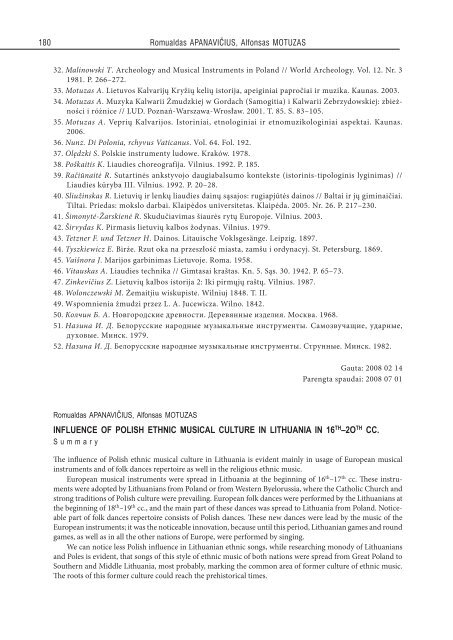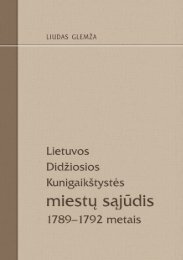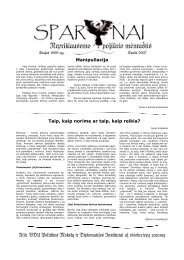Soter Nr. 26 - Vytauto Didžiojo universitetas
Soter Nr. 26 - Vytauto Didžiojo universitetas
Soter Nr. 26 - Vytauto Didžiojo universitetas
You also want an ePaper? Increase the reach of your titles
YUMPU automatically turns print PDFs into web optimized ePapers that Google loves.
180<br />
Romualdas APANAVIČIUS, Alfonsas MOTUZAS<br />
32. Malinowski T. Archeology and Musical Instruments in Poland // World Archeology. Vol. 12. <strong>Nr</strong>. 3<br />
1981. P. <strong>26</strong>6–272.<br />
33. Motuzas A. Lietuvos Kalvarijų Kryžių kelių istorija, apeiginiai papročiai ir muzika. Kaunas. 2003.<br />
34. Motuzas A. Muzyka Kalwarii Żmudzkiej w Gordach (Samogitia) i Kalwarii Zebrzydowskiej: zbieżności<br />
i różnice // LUD. Poznań-Warszawa-Wrosław. 2001. T. 85. S. 83–105.<br />
35. Motuzas A. Veprių Kalvarijos. Istoriniai, etnologiniai ir etnomuzikologiniai aspektai. Kaunas.<br />
2006.<br />
36. Nunz. Di Polonia, rchyvus Vaticanus. Vol. 64. Fol. 192.<br />
37. Olędzki S. Polskie instrumenty ludowe. Kraków. 1978.<br />
38. Poškaitis K. Liaudies choreografija. Vilnius. 1992. P. 185.<br />
39. Račiūnaitė R. Sutartinės ankstyvojo daugiabalsumo kontekste (istorinis-tipologinis lyginimas) //<br />
Liaudies kūryba III. Vilnius. 1992. P. 20–28.<br />
40. Sliužinskas R. Lietuvių ir lenkų liaudies dainų sąsajos: rugiapjūtės dainos // Baltai ir jų giminaičiai.<br />
Tiltai. Priedas: mokslo darbai. Klaipėdos <strong>universitetas</strong>. Klaipėda. 2005. <strong>Nr</strong>. <strong>26</strong>. P. 217–230.<br />
41. Šimonytė-Žarskienė R. Skudučiavimas šiaurės rytų Europoje. Vilnius. 2003.<br />
42. Širvydas K. Pirmasis lietuvių kalbos žodynas. Vilnius. 1979.<br />
43. Tetzner F. und Tetzner H. Dainos. Litauische Voklsgesänge. Leipzig. 1897.<br />
44. Tyszkiewicz E. Birże. Rzut oka na przeszłość miasta, zamšu i ordynacyj. St. Petersburg. 1869.<br />
45. Vaišnora J. Marijos garbinimas Lietuvoje. Roma. 1958.<br />
46. Vitauskas A. Liaudies technika // Gimtasai kraštas. Kn. 5. Sąs. 30. 1942. P. 65–73.<br />
47. Zinkevičius Z. Lietuvių kalbos istorija 2: Iki pirmųjų raštų. Vilnius. 1987.<br />
48. Wolonczewski M. Żemaitjiu wiskupiste. Wilniuj 1848. T. II.<br />
49. Wspomnienia żmudzi przez L. A. Jucewicza. Wilno. 1842.<br />
50. Колчин Б. А. Новгородские древности. Деревянные изделия. Москва. 1968.<br />
51. Назина И. Д. Белорусские народные музыкальные инструменты. Самозвучащие, ударные,<br />
духовые. Минск. 1979.<br />
52. Назина И. Д. Белорусские народные музыкальные инструменты. Струнные. Минск. 1982.<br />
Gauta: 2008 02 14<br />
Parengta spaudai: 2008 07 01<br />
Romualdas APANAVIČIUS, Alfonsas MOTUZAS<br />
INFLUENCE OF POLISH ETHNIC MUSICAL CULTURE IN LITHUANIA IN 16TH –2OTH CC.<br />
S u m m a r y<br />
The influence of Polish ethnic musical culture in Lithuania is evident mainly in usage of European musical<br />
instruments and of folk dances repertoire as well in the religious ethnic music.<br />
European musical instruments were spread in Lithuania at the beginning of 16 th –17 th cc. These instruments<br />
were adopted by Lithuanians from Poland or from Western Byelorussia, where the Catholic Church and<br />
strong traditions of Polish culture were prevailing. European folk dances were performed by the Lithuanians at<br />
the beginning of 18 th –19 th cc., and the main part of these dances was spread to Lithuania from Poland. Noticeable<br />
part of folk dances repertoire consists of Polish dances. These new dances were lead by the music of the<br />
European instruments; it was the noticeable innovation, because until this period, Lithuanian games and round<br />
games, as well as in all the other nations of Europe, were performed by singing.<br />
We can notice less Polish influence in Lithuanian ethnic songs, while researching monody of Lithuanians<br />
and Poles is evident, that songs of this style of ethnic music of both nations were spread from Great Poland to<br />
Southern and Middle Lithuania, most probably, marking the common area of former culture of ethnic music.<br />
The roots of this former culture could reach the prehistorical times.





